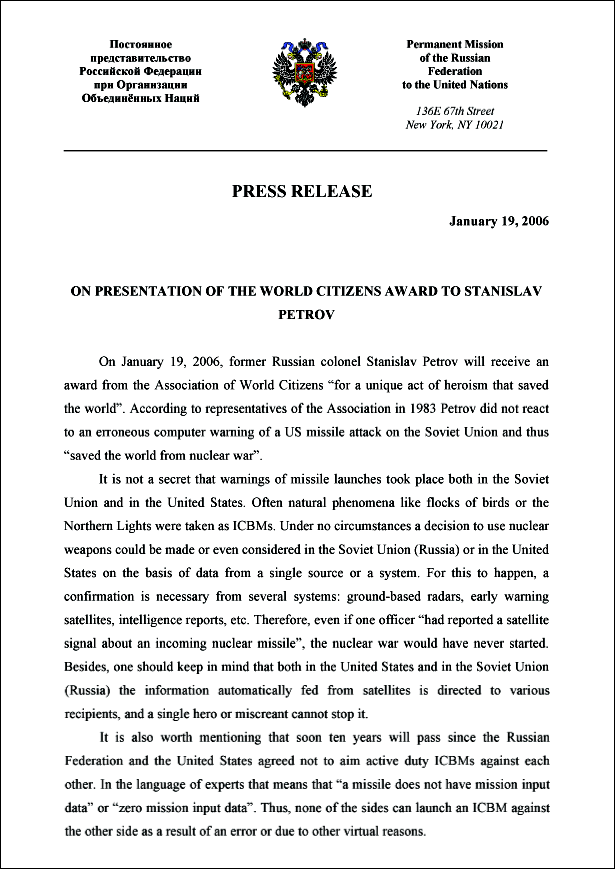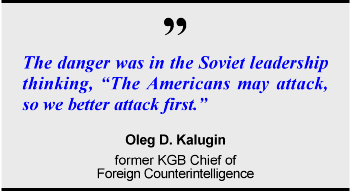On Jan. 19, 2006, in a meeting at the United Nations in New York City, Stanislav Petrov was honored for averting a potential worldwide nuclear war in 1983. However, also on Jan. 19, 2006, the Permanent Mission of the Russian Federation to the United Nations issued a press release, reproduced below, contending that a single individual would be incapable of starting or preventing a nuclear war. There are serious doubts, however, whether the position stated in the press release actually would have applied to the 1983 nuclear attack warning experienced by Stanislav Petrov. Below the press release is a differing point of view describing serious concerns related to the 1983 incident.


In a general sense, before nuclear weapons would be used in a “retaliatory attack,” standard protocol would require confirmation, as the press release above indicates, “from several systems: ground-based radar, early warning satellites, intelligence reports, etc.” If a nuclear attack warning were to occur today, it is very likely this process would be followed to the letter.
However, because of a multitude of disturbing circumstances surrounding the false nuclear attack warning experienced by Stanislav Petrov in 1983, it is not certain the Soviet leadership would have strictly adhered to “standard protocol.” In retrospect, there are compelling indications that the satellite warning itself on Sept. 26, 1983, would have been sufficient to have triggered a nuclear war — especially with the state of mind of the Soviet leadership at that time and the distressing intelligence reports continually being passed on to the Soviet leadership. Bruce Blair, an expert on Cold War nuclear strategies and currently a research scholar at Princeton University’s Program on Science and Global Security, in an interview with LogTV speaks of the instability of that time:
(The U.S.–Soviet) relationship had deteriorated to the point where I think the Soviet Union as a system — not just the Kremlin, not just Andropov, not just the KGB — but as a system, was geared to expect an attack and to retaliate very quickly to it. It was on hair-trigger alert. It was very nervous and prone to mistakes and accidents. And the shooting down of the Korean airliner is Exhibit Number A that that was the case — that this was an accident-prone, paranoid, nervous country, expecting a nuclear attack. The false alarm that happened on Petrov’s watch could not have come at a more dangerous, intense phase in U.S.–Soviet relations.
In the article “Cold War’s riskiest moment,” published in the Baltimore Sun Aug. 31, 2003, Scott Shane writes of the ever-increasing dangers in 1983:
...Ailing Soviet leader Yuri V. Andropov, urged on by Soviet hard-liners and acutely aware that his country was losing the military technology race, had become increasingly worried that the Americans might be planning a nuclear first strike. President Ronald Reagan’s rhetoric about the “evil empire” and U.S. military exercises poured fuel on Soviet war paranoia. A series of mishaps and misunderstandings made conceivable a catastrophe that would have dwarfed today’s worst fears of terrorists wielding weapons of mass destruction....
“In retrospect, it was a pretty terrifying time,” says Benjamin B. Fischer, a 30-year CIA veteran who now works on the agency’s historical staff. “We’re lucky it ended the way it did.” Fischer, who has published a seminal paper on the period through the CIA’s Center for the Study of Intelligence, says the danger resulted when wildly exaggerated fears of a U.S. surprise attack took hold in “the geriatric ward” of the aging Soviet leadership....
Behind the tensions of 1983 was a program devised in 1981 by then-KGB chief Andropov called Operation RYAN, not a code name but a stark Russian acronym for “nuclear missile attack.” Secret orders were issued to KGB officers around the world to look for signs, however subtle, that the United States might be preparing a preemptive strike.
KGB officer Oleg A. Gordievsky, who as a British agent later played a key role in the drama, watched RYAN unfold from KGB headquarters in Moscow and then as an intelligence officer posted to London. He saw a gulf between the views of worldly Soviet intelligence officers in the field and the paranoia of Kremlin leaders. “I never met anyone in the KGB who believed in the possibility of a first nuclear strike by the U.S.,” Gordievsky says in an interview from his home in England. “Yet they all reported on the signs of such an attack because they were ordered to do it. They were afraid to say what they really thought....”
Meanwhile, NATO plans to deploy Pershing II nuclear missiles in West Germany were seen by the Soviet Union as shortening to a few minutes the warning they might have of a strike. From Moscow, the Pershing deployment created fears like those that shook Washington when U.S. spy planes discovered Soviet missiles in Cuba.
“The danger was in the Soviet leadership thinking, ‘The Americans may attack, so we better attack first,’ ” says Oleg D. Kalugin, a former KGB chief of foreign counterintelligence, who lives outside Washington. While the KGB and military had institutional interests in exaggerating the risk of attack, Andropov’s distrust of American leaders was profound, says Kalugin, who knew him well.
Many incidents and factors in the weeks and months leading up to Sept. 25-26, 1983, contributed to the uncertainties of the time:
- The Soviet military shot down a Korean passenger jet Sept. 1, 1983 (only three weeks before the incident involving Stanislav Petrov), killing all 269 people on board, including many Americans. Soon after, the KGB sent a flash message to its operatives in the West, warning them to prepare for possible nuclear war, according to CNN.
- The American leadership began referring to the Soviet Union as an “evil empire.”
- Throughout 1983 the Kremlin assumed the West was planning a nuclear attack on the Soviet Union, according to experts quoted by the Federation of American Scientists.
- After President Reagan’s “Star Wars” speech March 23, 1983, the Soviets feared such a system would increase the likelihood the United States would launch a first attack since the United States would not fear retaliation, according to CNN.
- The Russians saw a U.S. government preparing for a first strike, headed by a President capable of ordering a first strike. Russian strategy is to fire its arsenal as soon as possible after receiving indications of an attack, according to Bruce Blair, an expert on Cold War nuclear strategies and currently a research scholar at Princeton University’s Program on Science and Global Security (Dateline NBC, Nov. 12, 2000).
- The United States and NATO were organizing a military exercise that centered on using tactical nuclear weapons in Europe. Soviet leaders were concerned this was a cover for an actual invasion. (IEEE Spectrum, March 2000)
Reflecting the attitudes and tensions of the time was an unsettling incident involving U.S. President Ronald Reagan. It occurred not long after the 1983 false nuclear attack warning experienced by Stanislav Petrov:
In testing the microphone for his weekly radio address — and not realizing that what he was about to say would be made public — President Reagan facetiously declared, “My fellow Americans, I’m pleased to tell you today that I’ve signed legislation that will outlaw Russia forever. We begin bombing in five minutes.”

brightstarsound@aol.com